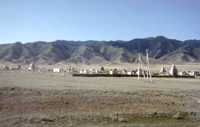1390 A.D. Conquest by Tamerlan (Aksak Timur).
15 – 16 centuries. The sultans Janibek and Kerey found the Kazakh State.
16th century. Kasim Khan unites the Kazakhs. Kazakh lands, to Russia and China.

1854 A.D. Building of the Russian fort Verniy at the place where Almaty is today.
1887 A.D. An earthquake destroys the town of Verniy.
1897 A.D. General census of the population, according to which the total number of people living in Kazakhstan was 9 295 000 of which number 29.8 % were the Kazakhs.
1916 A.D. The Kazakhs, the Kirghiz and the Uzbeks oppose the attempts of compulsory enrollment into the army in the years of World War I.
1920 A.D. Formation of the Kazakh Autonomous Republic within the Russian Federation.
1928 – 1933 A.D. Compulsory collectivization. Great Famine. 1.5 million people died.
1929 A.D. Almaty becomes the capital of the Kazakh Autonomous Republic.
1930 A.D. Building of the Turkistan-Siberian railway had been accomplished.
1930 – 1950 A.D. Repression and deportation of certain ethnical groups: Germans, Chechens, Koreans and some others were exiled to the Kazakh steps.
1936 A.D. Formation of the Kazakh Soviet Socialist Republic within the USSR.
1937 A.D. The year of formation of concentration camps and prisons for the “enemies of the people” which contained over 2 million people. The period of Stalin’s repressions.
1941 – 1945 A.D. World War II. Due to its geographical position, the most important economic resources (and some of the cultural valuables including creative intelligentsia) had been moved from the western parts of the Soviet Union to Kazakhstan.
1954 A.D. Beginning of development of virgin and unused lands according to Khrushev’s program. Intensive irrigation of the Kazakh steps for development of agriculture.
1979 – 1988 A.D. 21979 people from Kazakhstan took part in the war in Afghanistan.
December 17 – 18, 1986. Protests against the appointment of Kolbin head of the Kazakh government instead of Kunayev, former leader of the country. 200 people were killed in the main square of Almaty during the riot.
1989 A.D. According to the general census the population of Kazakhstan equaled 16465000.
1991 A.D. Dissolution of the USSR.
November 15,1993 A.D. The new national currency of tenge was introduced in Kazakhstan.
December 10, 1997 A.D. Akmola (Astana) is declared the capital of the republic.
2000 A.D. Oil companies on the north Kaspian shores declare about the largest oil deposit found in Kazakhstan within the previous 30 years and estimated at 15 -20 milliard barrels of oil. Completion of construction of the oil pipe-line to the Black Sea shores via Russia.
 Short note of Skiff (also known as Scythe or Saki) period
Short note of Skiff (also known as Scythe or Saki) period
Saki…That is how ancient Persians called the tribes that inhabited the steppes of Eurasia in early Iron Ages (VII – III centuries BC). Skilled warriors and craftsmen, they made a mark in a history with their perfect golden jewellery made in Scythe-Siberian animal style. The Chinese called them “Seh” and Greeks called them “Scyths” (Skiff). They were nomads, half-nomads and farmers. But above all, they were excellent in horse riding. Saki were first in the entire world to learn shooting a bow at a full gallop. It was Scythian and Saki horse rider that served as a prototype for the character of a fearless centaur – half-horse half-man. Swift squads of the steppe knights from mountainous and steppe regions of Eurasia crossed over the Caucasus Mountains in VII century BC and invaded the front Asia, bringing cities, palaces and temples to ruin. Concerned with their success, the Assyrian King Assargadon (689-669 BC) was seeking a treaty with them and thus was forced to marry his daughter off to the Skiff (Scythian) leader Partatua.
Saki cavalry appeared either at the walls of Urartu cities, or in Palestine, or dashed toward Egypt. Biblical prophet Jeremiah exclaimed: “Here come men from the lands of the North…they hold bows and short spears…Their voices roar like a sea, they ride their horses lined up as one man…Merely at hearing the word of their coming do we lose hearts…” Only by the end of VI century BC did the Saki warriors return to their steppes, bringing not only their loot trophies, but also the knowledge about the cultures of Media, Urartu and Assyria. Later on, Saki fought bloody wars with Ahamenids. Saki united with Persians to fight the ancient Greece and became famous at the battle of Thermopile. They successfully held defence against the soldiers of Alexander the Great and prevented the “conqueror of the world” from crossing the Yaksart River (Syrdarya) and entering the East. Saki art is distinctive with its inimitable peculiarities. It was called the Scythe-Siberian Animal Styly for its special approach, images and subject forms. Saki’s dishes, jewellery, clothing, armour and horse equipage all have images of deer and elks, horses, sheep and goats, leopards, tigers, panthers, birds and fishes. Images of some animals appear in combinations with symbolic and mythological meaning.
